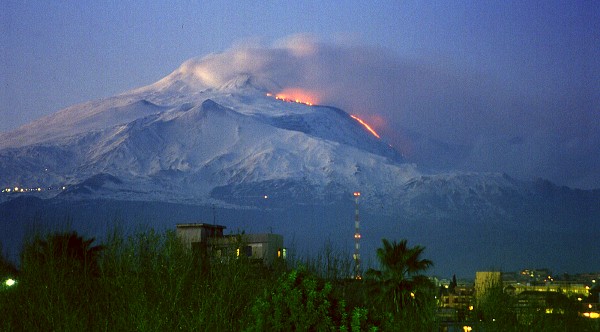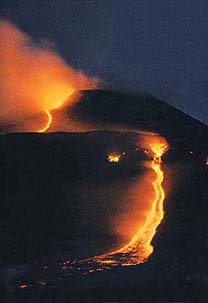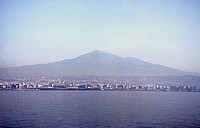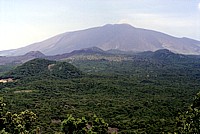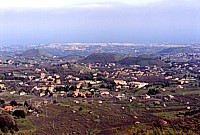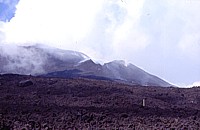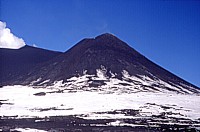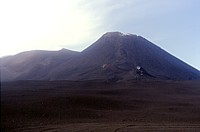| Etna
index |
||
| Geology | Geological history | Cones and craters |
| Eruptive characteristics | Eruptions before 1971 | Eruptions since 1971 |
| Etna and Man | References | Web sites |
| Weather forecasts | FAQ | Latest news |
Towering
above the city of Catania (315,000 inhabitants), Mount Etna is Europe's
largest volcano, and probably the second most active volcano on
Earth, with eruptions occurring almost continuously in its summit
area, and every few years on its flanks. This photograph, taken
on 13 February 1999 from the center of Catania, shows lava flowing
from an eruptive fissure close to the Southeast Crater (one of the
four summit craters of Etna) into the Valle del Bove, a deep collapse
depression on the eastern flank of the volcano. Though spectacular,
this eruption did not cause any damage, but attracted hundreds of
thousands of tourists over the nine months of its duration |
Etna Volcano, Sicily, Italy
volcano number: 0101-06= (according to Volcanoes of the World, 1994 edition)
summit elevation: 3329.6 m (as of July 2007)
location: 37.734�N, 15.004�E
![]()
Mount Etna is Europe's largest volcano (its volume is at least 350 km3), and one of the most active (in the sense of "productive" and eruption frequency) volcanoes on Earth, with frequent periods of intermittent to persistent activity in the summit area and major eruptions from new vents on its flanks every 1-20 years. The main feature of Etnean activity is voluminous lava emission, but strong explosive activity occurs occasionally, mostly from its presently four summit craters. Some of the eruptions from its flanks also show high degrees of explosivity, such as those in 1669, 1879, 1892, and 2002-2003.
Etna lies near the eastern (Ionian) coast of Sicily and occupies a surface area of around 1200 km2 with a perimeter exceeding 135 km. Its summit height varies frequently in function of eruptive activity or minor collapse events at the summit craters: through the early 1980s it showed a net increase by nearly 100 m to an unprecedented 3350 m in 1981, but since then it has progressively decreased to 3329.6 m at the beginning of the new millennium.
The name Etna probably has its origin in a mixture of the Latin and Greek words for "to burn", although an alternative hypothesis is that it is actually derived from the Phoenician word "athana", which means "furnace". Both hypotheses appear quite plausible and show how early populations near the volcano were impressed by its frequent eruptions.
Many geographic maps of Etna show a second name at the site of the volcano, Mongibello, a name derived from a mixture of the Roman word mons and the Arabian word gibele, or jebel, both of which mean "mountain". Etna has thus the privilege to be "Mount Mountain" in the mentality of the people living around it, and this is justified. In Sicily Etna is THE mountain, 'a muntagna in the local dialect. It is another noteworthy detail of the consideration Etna enjoys in the hearts of the people dwelling at its sides that the mountain is considered to be female which is not a typical way of considering mountains in Europe. Etna is the big Mamma (and when seeing it with its many little cones from flank eruptions, this idea is quite understandable) who gives and takes, and has created this particular place on Earth.
Etna is particular for a number of reasons. First, it has the longest record of historical eruptions (see Volcanoes of the World, 1994 edition) among all volcanoes on this planet, its first historically documented eruption occurring at about 1500 BC. The total number of eruptions is 209 (18 among them questionable) through late 1993 (Volcanoes of the World). To these, there have now to be added the spectacular and vigorous summit eruptions of 1995-2001, the flank eruption of July-August 2001, the modest summit eruptions of the summer of 2002, and the dramatic flank eruption that lasted from October 2002 until late January 2003. Certainly we will not have to wait long to add yet another eruption, either at the summit or somewhere on the flanks, to this impressive record.
Etna lies in an area that is still not well understood from a geological standpoint. While some scientists relate, in a broader sense, the Etnean volcanism to subduction of the Ionian oceanic seafloor beneath the Calabrian Arc (with volcanism on the Aeolian Islands as one consequence), others postulate a hot spot beneath Etna, thus explaining its high lava production and fluid mafic magmas. Still another hypothesis sees Etna in a complex rifting environment. Among the few things which are quite well understood is the fact that the volcano lies at the intersection of several major regional fault systems, and this probably facilitates the uprise of magma right in this place. It is evident that Etna lies in a very complex geodynamic environment hardly comparable to any other region on Earth. There is some evidence that Etna is but the most recent manifestation of volcanism fed from a very long-lived mantle source, having caused numerous earlier phases of mafic volcanism in the Monti Iblei, SE Sicily, from the late Triassic to the early Pleistocene.
Although it is generally considered a rather benign volcano, like Kilauea on Hawaii and Piton de la Fournaise on Réunion island in the Indian Ocean, in the sense that it does not produce devastating explosive eruptions, Etna's eruptions represent a significant threat to human property and dwellings in the vicinity. This is mainly due to the frequency of eruptions on the flanks, sometimes at low elevation and thus close to inhabited areas, and to the presence of numerous towns and villages on the volcano's flanks, especially on the southern and southeastern sides. On several occasions during history, population centers have been partially or totally destroyed by lava flows, most recently in 1669 and 1928, and much more often has cultivated land been buried by lava flows. Lava flows are in fact produced during all eruptions of Etna and represent by far the greatest hazard to human property. But although it generally does not produce powerful explosive eruptions like Mount St. Helens or Pinatubo, or some of its Italian companion volcanos such as Vesuvio and Vulcano, Etna's explosive potential has been underestimated until recently. The flank eruptions in 2001 and 2002-2003 have not only shown that Etna is well capable of significant explosive activity, but also that the society living next to the volcano has grown highly vulnerable, with ground and air traffic being most sensible to ash falls.
Still Etna is called by the local people a "good volcano", and in spite of the existing hazards, this concept is not all that wrong. Life near Etna has a number of benefits: the fertility of the volcanic soils, the favorable climate conditioned by the presence of a large mountain close to the sea, and, last but not least, Etna rarely kills people. The existing historical record allows to state that less than 100 people have been killed by eruptions of this volcano in the past >2000 years, although the record is not complete prior to AD 1600. Most of these fatalities occurred close to the sites of eruptions, and the victims were nearly always "in the wrong place at the wrong time": they were watching eruptions or were at the summit in periods of unpredictable explosive activity. Not a single case of people being surprised in their homes by eruptions is documented for Etna.
A Guide to the Etna Pages
The "Etna" section of this site is organized much like a book with various chapters, although these "chapters" must not necessarily be consulted in the order as they are arranged here.
The first two chapters - "Geology" and "Morphology" - deal with the tectonic environment, geological evolution, structure and morphology of Etna. The "Geology" chapter gives an outline of the tectonic conditions which are believed to favor the uprise and eruption of magma; as you will see, this is a subject still under debate, and rather than adhering to one particular model, I summarize those proposed by various authors. Furthermore, a summary of the geological evolution of Etna is given, a necessary tool for understanding the complicated structure and morphology of Etna which is discussed in the subsequent chapter. The two main morphologic elements of Etna are the Valle del Bove, a large collapse depression on the E side of the volcano, and its numerous cones and craters (as well as eruptive fissures). In this latter context, you will get acquainted with the summit craters (since 1971 there are no less than four of them), and learn about the cones produced by flank eruptions, thus getting introduced to some basic principles of the eruptive behavior of Etna. More detail about the more than 300 cones, craters and fissure vents on the flanks is given on a page entitled "Mamma Etna's countless children".
There is much information about eruptions in the following two chapters, which deal with historical eruptions and eruptive processes. The first of these chapters presents the different types of eruptions and provides an overview of what is known about the processes of magma uprise and movement within the volcano; much of this information is derived from the geophysical monitoring of Etna which lived through some of its most exciting moments before and during the flank eruptions of 2001 and 2002-2003.
Historical eruptions are the subject of the next chapter, where you will find lists of historical eruptions before 1900 and since 1900, and brief descriptions of the more important events. From 1900 on, each eruption is summarized, and maps are shown for all eruptions since 1950. Maps and descriptions of all eruptions since 1971 are also available on a separate page. New pages describe the most recent major eruptions, in the summer of 2001 and in 2002-2003.
The most recent eruptive activity is summarized in a special part of the Etna pages, and consists of the Etna News Page (usually this page contains the updates of the current month) and of archived updates (back to May 1997). This section contains numerous photos, many of which are also accessible in a completely re-organized Photo Gallery. As of early 2004, this photo gallery contains images of the years 1989 to early 1998, 2001, 2002 and 2003 as well as of the mud volcanoes (known as the "Salinelle") on the southern base of Etna. Many of these images are of relatively low quality. New, higher-resolution scans from my old slides and negatives are available on my Flickr photo pages; these also contain a wealth of more recent digital photos.
To see the ongoing activity
on Etna, which means to visit the volcano, one depends heavily on the
weather conditions which, at such a large mountain, change rapidly. You
may consult various web sites that have weather forecasts for the Etna
area, which are linked on the Etna Weather
Forecasts page (these links might not work anymore).
The effects of the presence and activity of Etna on the people living
around the volcano are analyzed in more detail in a chapter entitled "Etna
and Man". You will get a first-hand impression of how life on
the volcano really is - based on my personal experience since early 1997
and many visits during the preceding eight years - and then be guided
to a discussion of the dangers and destructive eruptions of Etna more
accurate and realistic than you will probably find elsewhere. The nucleus
of this chapter lies in the chronology of eruptions which killed people
and/or caused material damage, and it will probably modify your idea of
Etna which is often thought to be a killer volcano, based on false information
in many sources. However, the study of eruptive events of the past reveals
that this volcano has experienced quite violent moments, and thus might
do so again in the future. Assessments of volcanic
hazards in the Etna region must include the - albeit remote - possibility
of powerful explosive eruptions, lava emission from vents on the lower
flanks, and collapse of a portion of the mountain to form debris avalanches.
The last chapter consists of a page that leads you to other web sites that have information about Etna, some more and others less detailed - some of these links might be obsolete. You will also find a link to a page with references of Etna (scientific articles and other publications).

visitors since 19 February 1999
FastCounter by LinkExchange
visitors since 19 February 1999
FastCounter by LinkExchange
Copyright © Boris Behncke, "Italy's Volcanoes: The Cradle of Volcanology"

